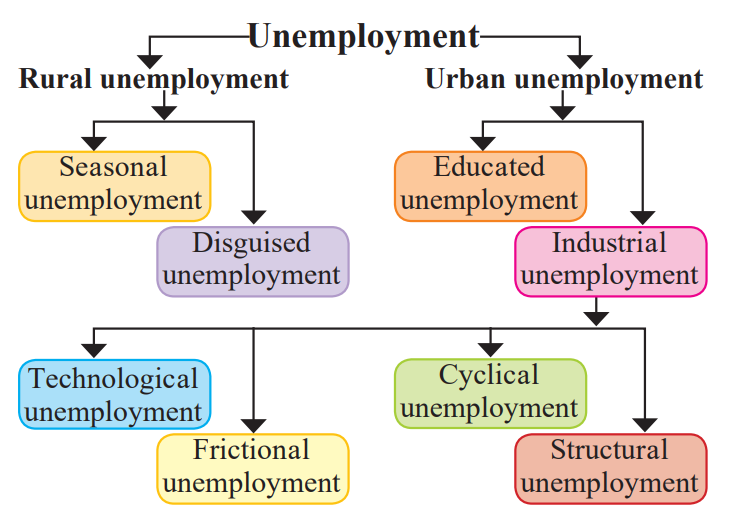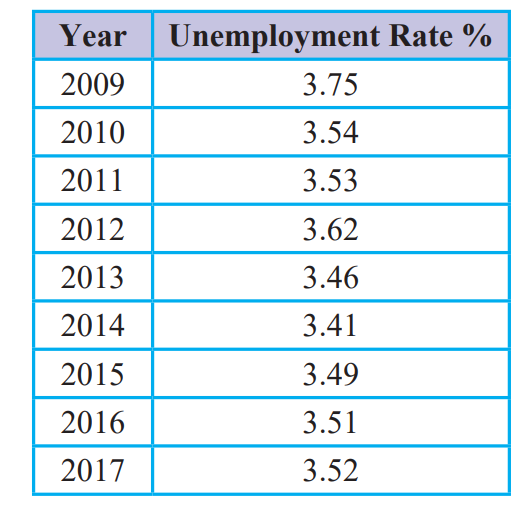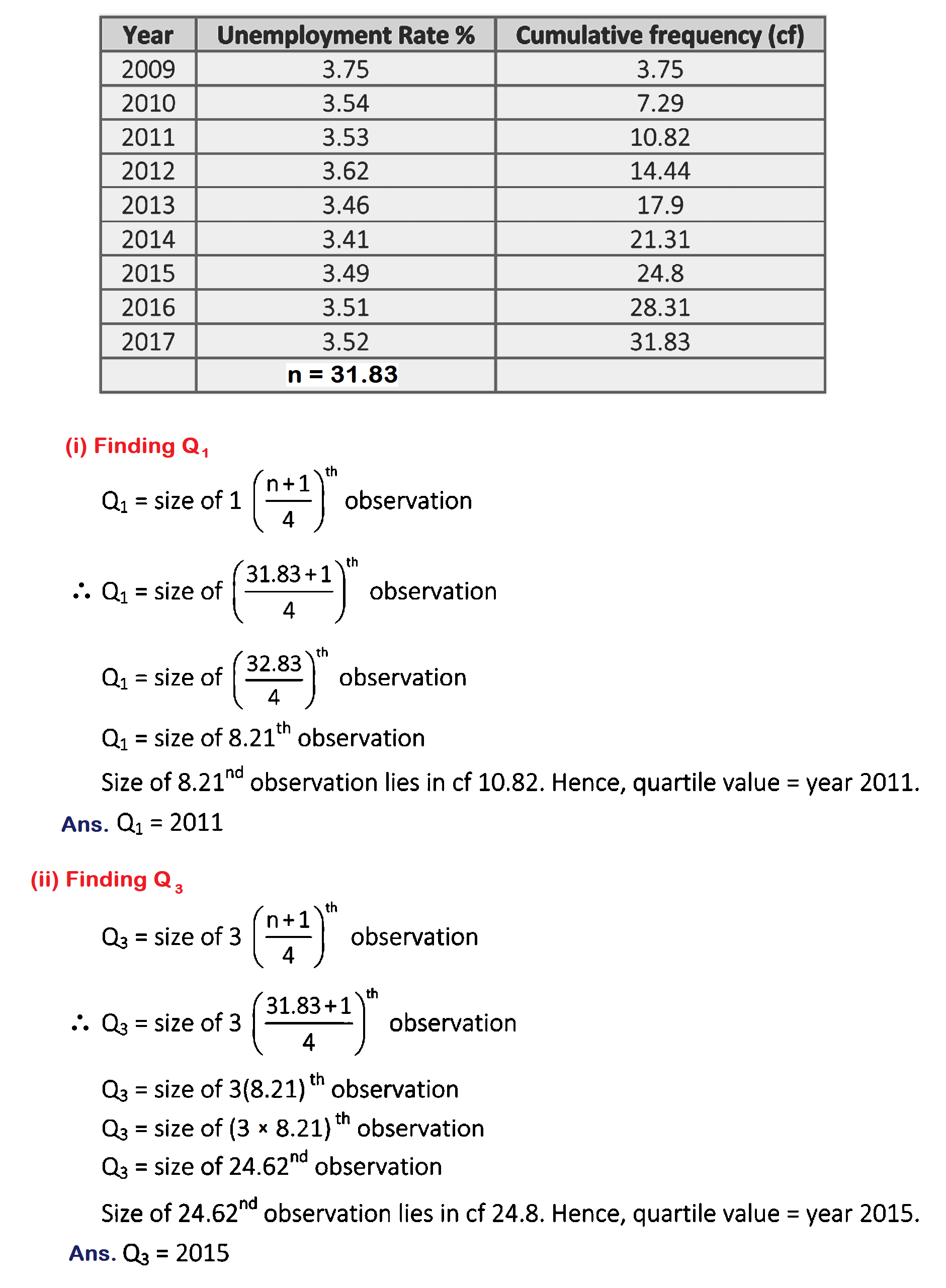Q. 1. Find the odd word out :
1) Urban unemployment –
options:
(1) Educated unemployment,
(2) Industrial unemployment,
(3) Disguised unemployment,
(4) Technological unemployment
2) States with high rates of unemployment –
options:
(1) Goa,
(2) Punjab,
(3) Maharashtra,
(4) Tripura
(3) Employment Guarantee Scheme 1972
options:
Jawahar Rozgar Yojana 1989
Swarnajayanti Gram Swarozgar Yojana 1999
Development of Tourism.
Q. 2. Identify and explain the concepts from the given illustrations :
1) Hussain Shaikh employed seven workers less than the usual number of workers on his farm, in spite of this, output remained the same.
Ans.
Identified concept: Disguised unemployment.
Explanation of concept: Disguised unemployment is a type of rural unemployment in Which surplus manpower has zero marginal productivity.
2) Use of new technology in the printing industry has led to unempolyment among several workers.
Ans.
Identified concept: Technological unemployment.
Explanation of concept: Technological unemployment is a type of industrial (urban) unemployment that arises due to the use of modern capital intensive technology.
3) Satish has completed his post graduation and is desperately expecting a job.
Ans.
Identified concept: Educated unemployment.
Explanation of concept: Educated unemployment is a type of urban unemployment in Which educated people are willing to work but do not get jobs.In certain agricultural areas of Maharashtra, only Kharif crops are grown, therefore employment is available till the month of October.
4) In certain agricultural areas of Maharashtra only kharif crops are grown, therefore employment is available till the month of October.
Ans.
Identified concept: Seasonal unemployment.
Explanation of concept: Seasonal unemployment is a type of rural unemployment in which a large number of people are employed in the season but remain unemployed in the offseason.
Q. 3. Complete the correlation :
1) Seasonal unemployment : Tourist guides; ___________: Graduates
Ans. Educated unemployment
2) __________ : Disguised unemployment; Urban unemployment : Industrial unemployment
Ans. Rural unemployment
3) Frictional unemployment : Shortage of raw materials ; __________ : Fluctuations in business activity
Ans. Cyclical unemployment
4) MGNREGS : guaranteed wage employment; TRYSEM : _________
Ans. Enabling to become self-employed.
5) _________ : Waste of resources. Social effect : loss of human dignity
Ans. Economic effect
Q. 4. Observe the following chart and answer the following questions.

1) Production does not increase if additional worker is employed and production does not decrease if worker is reduced from the work. Mention the type of unemployment.
2) A worker is thrown out of job because of computerisation. Name this type of unemployment?
3) Sharad was forced to return back to India from USA due to depression in IT sector.
4) In spite of being a graduate, Vasant is sitting idle at home.
Solution.
1. Disguised unemployment.
2. Technology unemployment.
3. cyclical unemployment.
4. Educated unemployment.
5. The introduction of computers has caused unemployment among manual typists.
Q. 5. Find out Q1 and Q3 using unemployment rates as numerical data :

Solution:

Q. 6. Answer the following in detail :
1) Explain the types of Industrial unemployment in India.
Ans.
The types of unemployment in India are as follows:
A. Technological Unemployment:
Technological unemployment arises because of changes in technology. Modern technology is capital-intensive and requires less laborers. When new techniques are introduced in the industrial sector, existing workers become unemployed due to lack of proper training, for example, computerization, the introduction of robotic technology, etc. led to technological unemployment.
B. Frictional Unemployment:
Frictional unemployment is caused due to the breakdown of machinery, power failure, shortage of raw materials, strikes by workers, etc. Frictional unemployment is temporary by nature.
C. Cyclical Unemployment:
Cyclical unemployment is the result of cyclical fluctuations in business activity. Every economy passes through phases of prosperity and depression. During the period of depression, effective demand falls. This further leads to a fall in the prices and profits earned by the producers. As a result, investment and production of commodities fall. A fall in production leads to a fall in employment. As a result, workers lose jobs during the period of depression.
D. Structural Unemployment:
Drastic changes in the economic structure of a country lead to structural unemployment. These changes may affect either the supply of or demand for a factor of production. Structural changes in the economy are caused by changes in government policies, shortage of capital, shifting of the industry from one region to another, etc. Structural unemployment is a long-term phenomenon. It takes place because of a mismatch between the skills of workers and the jobs that are actually available. ‘ For example, the introduction of computerized typing has caused unemployment among manual typists.
2) Explain the causes of unemployment in India.
Ans.
The following are the causes of unemployment in India:
Jobless growth: In India, since independence, the rate of growth of employment has been considerably less than the rate of economic growth. Moreover, the rate of economic growth has not been adequate enough to absorb the increasing labour force in India. As a result, there is widespread unemployment.
Increase in the labour force: In India, the death rate has rapidly declined without a corresponding fall in the birth rate. As a result, the population of India is increasing day-by-day. This has resulted in an equally large expansion in the labour force leading to unemployment.
Excessive use of machinery: In India, manpower is available in large quantities. Under these circumstances, the country would have a labour intensive technique of production. However, in India, not only in industries but also in agriculture, the capital-intensive technique of production is being used. This policy results in large scale unemployment.
Lack of skill development programmes: In India, vocational skill development courses Which are compatible with the Indian industry are comparatively less in number. So, there is a dearth of skilled manpower needed by the industry.
Expectations towards employment: Educated youth in India aspire for a white-collar job. There is a lack of innovative and entrepreneurial spirit to organize economic activities Where they can be self-employed. In India, most of the graduates prefer to remain unemployed till they get a job which is up to their expectations in terms of salary and nature of work.
Seasonal nature of agriculture: Agriculture in India is seasonal by nature. It depends on the monsoon. Lack of irrigation facilities, poor soil fertility, outdated production techniques, non-availability of certified seeds and fertilizers are the factors that reduce the capacity of agriculture for other gainful employment throughout the year. The labourers are employed only for a few months in a year. For the rest of the year, the labour force remains jobless.
The slow rate of economic development: The overall economic development of India is very slow. Inadequate irrigation facilities, fertilizers. unsatisfactory growth of infrastructure is all due to inadequate industrial expansion. As a result, employment Opportunities have not increased enough in the rural sector to absorb the growing labour force.
Migration of rural population: There has been a continuous migration of people from rural to urban areas in search of jobs. This has increased the problem of unemployment in urban areas.
3) Explain the measures taken by the government to reduce unemployment.
Ans.
The measures taken by the government to reduce unemployment are as follows:
Employment Guarantee Scheme (EGS): Employment Guarantee Scheme was first introduced by the Government of Maharashtra on 28th March 1972. This scheme was intended to provide productive employment to the rural population and thereby solve the problem of rural unemployment and poverty. Under this scheme, the government assures to provide minimum employment opportunities. Due to its success in Maharashtra, EGS was implemented in other states as well.
Swarnajayanti Gram Swarozgar Yojana (SGSY): This scheme was launched in April 1999 after restructuring the Integrated Rural Development Programme (IRDP) and allied schemes. It is the only self-employment scheme for the rural poor in India.
Swarna Jayanti Shahari Rozgar Yojana (SJSRY): This scheme was launched in December 1997. It provides employment to the urban unemployed and underemployed. It included self-employment, women self-employment program, skill training for employment promotion, and urban wage employment Programme. For this scheme, the Central Government shares 75% of the cost and the State Government shares 25% of the cost.
Pradhan Mantri Rozgar Yojana (PMRY): this scheme is being implemented since 1993.it aims at creating and providing sustainable self-employment opportunities to more than one million educated unemployed youth.
Training Rural Youth for Self-employment (TRYSEM): It was initiated in 1979 with the objective of tackling the unemployment problem among the rural youth. It aimed at training about 2 lakh rural youth every year to enable them to become self-employed. TRYSEM was merged into Swarnajayanti Gram Swarozgar Yojana in April 1999.
Jawahar Rozgar Yojana (JRY): On 1st April 1989, the Government announced a new wage employment scheme, the Jawahar Rozgar Yojana for intensive employment creation in 120 backward districts. It was restricted to rural areas. With effect from April 1999, it was renamed as Jawahar Gram Samrudhi Yojana (JGSY).
Mahatma Gandhi a National Rural Employment Guarantee Scheme (MGNREGS): Since 2nd October 2009, National Rural 31 Employment Guarantee Scheme has been renamed as Mahatma Gandhi National Rural Employment Guarantee Scheme. This scheme provides at least 100 days of guaranteed wage employment in a financial year to at least one member of every rural household whose adult member volunteers to do unskilled manual work.
Deen Dayal Upadhyaya Grameen Kausalya Yojana 2014: it is the most important placement linked skill training program under the ministry of rural development announced on September 23, 2014. The aim of this scheme is to reduce poverty as well as provide gainful and sustainable employment through regular wages. The focus of this program is on the rural youth from families, in the age group of 15-35 years.
National Policy for Skill Development and Entrepreneurship 2015: The first National policy on skill development was notified in 2009 to promote private sector participation Via innovative funding models.
The objective of this scheme is to co-ordinate and strengthen factors essential for the growth of entrepreneurship across the country. This would include:
1. Promote entrepreneurship culture.
2. Encourage entrepreneurship as a viable career
option through advocacy.
3. Promote entrepreneurship among women.
Start-up India Initiative: It was introduced in January 2016 with an aspiration to impart more strength and inspiration to the talented young generation of India to do something new for India and humanity.
Pradhan Mantri Kaushal Vikas Yojana (2016-20): The objective of this scheme is to encourage skill development among youth by providing monetary rewards for successful completion of approved training programs. The government has allocated a budget of 12,000 crores till 2020 for the implementation of the scheme.